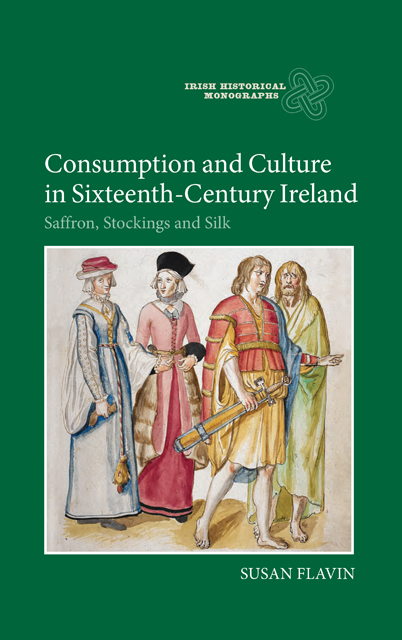6 - Colour and Cleanliness
Published online by Cambridge University Press: 24 February 2023
Summary
Dyestuff
Comparing de Heere’s sixteenth-century illustrations of Irishwomen and Englishwomen, Dunlevy noted distinct differences in their styles of headwear, ruffs, sleeve shapes and also, significantly, in the colour of their clothing. The English, she remarked, were depicted in patterned fabrics with muted, dark tones in contrast with the brighter colours worn by the Irish. This was a fact also acknowledged by contemporary literary commentators on Irish habits. Spenser remarked, for example, that Irishwomen ‘will devise some colour, for either of necessity, or of antiquity or of comeliness’. Likewise, Gernon noted that the mantles worn by Irishwomen were ‘commonly of a browne blew colour with fringe alike, but those that love to be gallant were them of greene, redd, yellow, and other light colours, with fringes diversifyed’. The apparent differences in Irish and English colour preferences during this period may perhaps be further understood in light of recent discussion on the evolving significance of colour and on the ideological factors that influenced its use during this period.
Paul Raffield has argued that the expansion of sumptuary legislation in England, which included the regulation of clothing colour, was driven predominantly by the Protestant Reformation and Renaissance Humanism. He has suggested that the regulation of dress became an important means of expressing the authority and ‘indivisibility of divine and common law’. In contrast to the sumptuary laws enacted prior to the Act of Supremacy (1534), the purpose of which was to enforce respect for a feudal hierarchy and restrict the import of foreign goods, legislation enacted after the Henrician Reformation ‘reflected an emergent, modern constitution which embodied a particular, English form of Protestantism based upon moderation, repression of excessive individualism and a belief in the divinity of law and its institutions’.
The regulation of colour was central to this so-called ‘reformation of the image’. Legislation enacted by the Crown in 1533, in an attempt to depict the monarch as the ‘unique embodiment of divine law’ stated that no person should ‘use or weare in any maner their apparel, or upon their horse, mule, or other beast, any silke of the colour of purpure, ne any cloth of Gold tissue, but onely the King’ and certain specified close relatives.
- Type
- Chapter
- Information
- Consumption and Culture in Sixteenth-Century IrelandSaffron, Stockings and Silk, pp. 118 - 140Publisher: Boydell & BrewerPrint publication year: 2014



